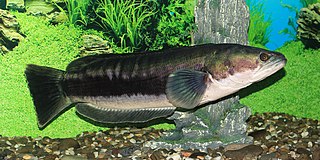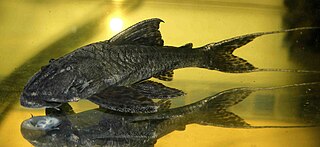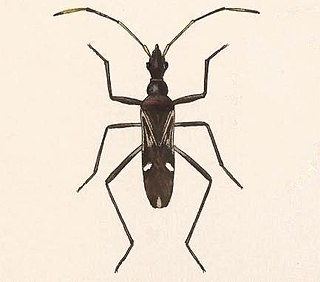
Characidae, the characids or characins is a family of freshwater subtropical and tropical fish, belonging to the order Characiformes. The name "characins" is the historical one, but scientists today tend to prefer "characids" to reflect their status as a by and large monophyletic group at family rank. To arrive there, this family has undergone much systematic and taxonomic change. Among those fishes that remain in the Characidae for the time being are the tetras, comprising the very similar genera Hemigrammus and Hyphessobrycon, as well as a few related forms such as the cave and neon tetras. Fish of this family are important as food and also include popular aquarium fish species.

Channa is a genus of predatory fish in the family Channidae, commonly known as snakehead, native to freshwater habitats in Asia. This genus contains about 50 scientifically described species. The genus has a wide natural distribution extending from Iraq in the west, to Indonesia and China in the east, and parts of Siberia in the Far East. A particularly high richness of species exists in Myanmar (Burma) and northeastern India, and many Channa species live nowhere else. In contrast, a few widespread species have been introduced to several regions outside their natural range where they often become invasive. The large and medium-sized Channa species are among the most common staple food fish in several Asian countries and they are extensively cultured. Apart from their importance as a food fish, snakeheads are consumed in some regions as a traditional medicine for wound healing and reducing post-operative pain and discomfort, and collected for the international aquarium pet trade.

The black swallower, Chiasmodon niger, is a species of deep sea fish in the family Chiasmodontidae. It is known for its ability to swallow fish larger than itself.

Hemiancistrus is a genus of suckermouth armored catfishes. These species are native to South America. The taxonomy of this genus is complex and unclear, and major work has to be done. Many of these fish are popular aquarium fish.
Hisonotus is a genus of armored catfishes native to South America. Species of Hisonotus and Curculionichthys are the only representatives of the subfamily Otothyrinae having serrae on the posterior edge of the pectoral fin spine. These species are small fishes, generally found in small fast flowing streams, where they grasp to the branches and leaves of aquatic or subaquatic plants. The species of this genus mostly occur in Atlantic coastal streams of southern Brazil and the Paraguay-Paraná system of southern South America. They are also distributed in the Río de La Plata basin and coastal rivers of southeastern Brazil.

Garra is a genus of fish in the family Cyprinidae. These fish are one example of the "log suckers", sucker-mouthed barbs and other cyprinids commonly kept in aquaria to keep down algae. The doctor fish of Anatolia and the Middle East belongs in this genus. The majority of the more than 140 species of garras are native to Asia, but about one-fifth of the species are from Africa.

Trachiniformes is an order of percomorph bony fish which is traditionally the suborder Trachinoidei of the Perciformes.

Rhynchoconger is a genus of eels in the family Congridae.

Tetragonopterus is a genus of fish in the family Characidae native to South America.

Characidium is a genus of fish in the family Crenuchidae. They are mainly found in South America, but C. marshi is from Panama. They are small, slender fish that live on the bottom in flowing fresh waters and feed on small animals such as insects.
Curimatopsis is a genus of small South American fish in the family Curimatidae. They are native to freshwater habitats in the Amazon, Orinoco and Paraguay basins, as well as river of the Guianas.

Chiasmodon is a genus of snaketooth fishes.

Kali is a genus of snaketooth fishes, deep ocean fish from the family Chiasmodontidae.

Pseudoscopelus is a genus of snaketooth fishes.

Opecoelidae is a family of trematodes. It is the largest digenean family with over 90 genera and nearly 900 species, almost solely found in marine and freshwater teleost fishes. It was considered by Bray et al. to belong in the superfamily Opecoeloidea Ozaki, 1925 or the Brachycladioidea Odhner, 1905.
Melvius is a genus of vidalamiin amiid fish from the Late Cretaceous. The type species, Melvius thomasi, was described by Bryant in 1987. A second species Melvius chauliodous, was named and described by Hall and Wolburg in 1989, and it is now considered to be one of the index taxa of the Kirtlandian land-vertebrate age.
Brotulotaenia brevicauda is a benthopelagic marine fish species in the family Ophidiidae. This totally black fish is usually found in the Atlantic Ocean but it has also been reported in the Indian. B. brevicauda lives in deep water and grows up to 32 cm in length. It is also occasionally known as the Short-tail cusk-eel.

Heraeus is a genus of dirt-colored seed bugs in the family Rhyparochromidae. There are at least 40 described species in Heraeus.

Scombriformes is an order of bony fish containing nine families which were classified under the suborders Scombroidei and Stromateoidei, of the wider grouping known as Perciformes, Nelson (2016) recognised the order but subsequent workers have suggested that Scombriformes forms part of the larger Pelagiaria clade.

Dysalotus alcocki is a species of deep sea fish, a swallower, from the family Chiasmodontidae which is found in the tropical and temperate oceans around the world. The adults fed mainly on fish. The juveniles and larvae are most frequently recorded from shallower waters while adults are mostly caught from depths of over 1,000 metres (3,300 ft). The generic name is derived from the Greek dysalotos which means "difficult to catch" and the specific name honours the English zoologist Alfred William Alcock (1859-1933).















